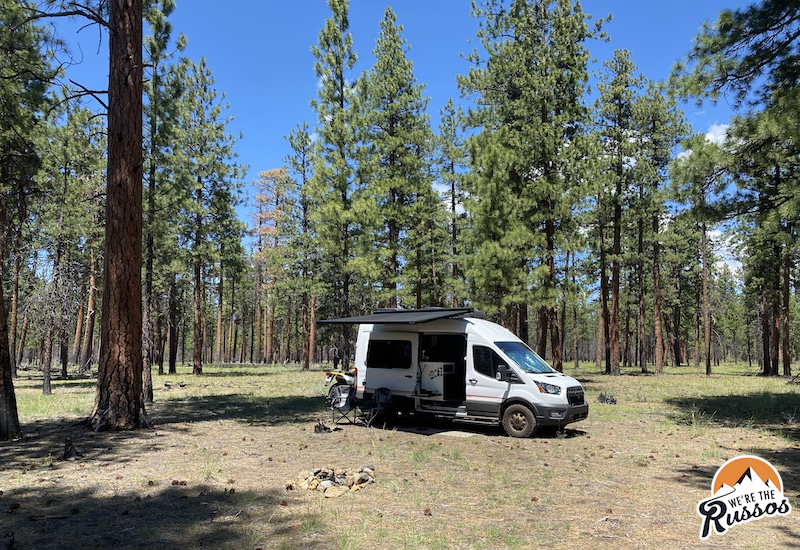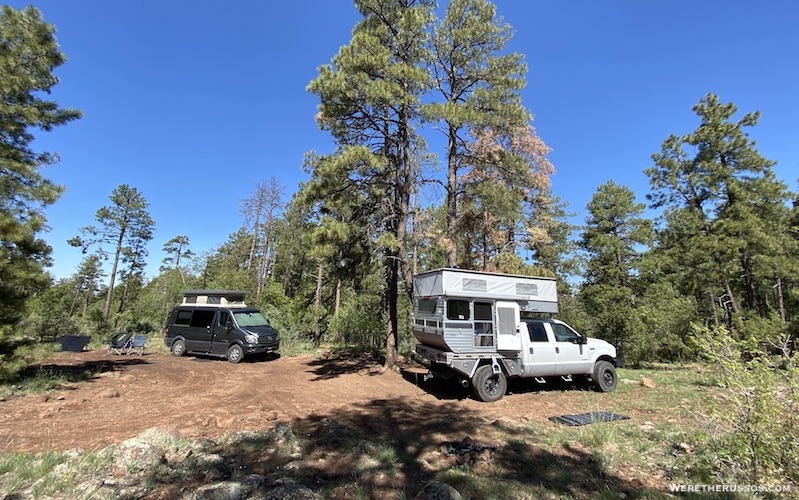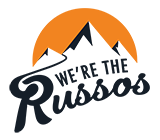This post may contain affiliate links.
If you’ve watched any of our videos on YouTube, you’ve probably heard us talk about dispersed camping or free camping in national forests. In this post, I’ll explain what dispersed camping is, how to find it, and share some free camping tips. By the time you’re done reading this post, you’ll be able to find your own dispersed camping sites in national forests.
Dispersed Camping Guide

What is Dispersed Camping?
According to the U.S. Forest Service, dispersed camping is “camping anywhere in the National Forest outside of a designated campground.” In other words, dispersed camping means camping for free on public land.
Dispersed camping can also be done on BLM (Bureau of Land Management), which is technically subject to different jurisdiction than the Forest Service, but the principal is the same.
You can enjoy free camping in National Forests, often for up to 14 days at a time. For those of you new to dispersed camping in your RV, this means camping with no electrical, water, or sewer hookups.
In some cases, there are official “primitive” campsites with pit toilets. Most of the time these primitive camping spots offer no amenities, except for the occasional fire ring. Other times, you simply pull off the road into an area that’s clear enough to camp in.
Why go Dispersed Camping?
Beyond the the fact that dispersed camping is free, it also provides a different type of camping experience on public land.
Unlike staying at a campground where you might be able to reach into your neighbor’s window because the sites are so close together, dispersed camping can offer camping experiences in open wilderness areas. Your closest neighbor, if you even have one, may not even be visible through the trees. You can start and end each day listening to the sounds of nature. The stars are so bright at night that you can see the Milky Way, and you’ve never seen so many stars.
These are some of the reasons why we love dispersed camping. It’s the opportunity to get closer to nature than you can ever get in a campground, and it’s free!
We’ve filmed several videos while boondocking in National Forests. Here’s one filmed in Oregon at one of our favorite dispersed camping sites.
Of course, if you’re camping away from traditional amenities like water, sewer, and electric hookups, you need to take that into account and do some preparation. Read up on the Pros and Cons of Boondocking.
Dispersed Camping for All
Since 2015, we’ve enjoyed dispersed camping in various types of campers, and we’ve observed others camping in tents, hammocks, and even their vehicles. Although not all dispersed camping sites can accommodate larger campers, there’s certainly something to suit everyone’s needs.
Here’s a video we made about dispersed camping in the Coconino National Forest while living full time out of our Class A motorhome towing a Jeep Wrangler.
How to Find Dispersed Camping
There are several ways to find National Forest dispersed camping spots. Below are some of the best methods we’ve found. Don’t limit yourself to just one of these. Depending on where you are and what kind of camper you have, one might work better than another. At a minimum, plan to research using 2-3 different sources before deciding on a dispersed camping area.
1. Forest Service or Bureau of Land Management
This might sound painfully obvious, but a great way to find dispersed camping spots in National Forests or on BLM is to check directly with the Forest Service or the Bureau of Land Management for the area you’re in.
The rangers who work each area will know it better than anyone, and this is probably the best method out there for getting accurate, up-to-date information and exact directions. You’ll also get advice that’s tailored to you and your rig.
For example, if you are interested in dispersed camping in Hoosier National Forest, visit the official page and you will find a section on dispersed camping. Explore a bit more and you will find an abundance of information including contact information, should you wish to speak to a ranger.
Forest Service Office
If you’re in or near a National Forest, seek out the nearest Forest Service office and ask for a Motor Vehicle Use Map. The ranger can use this map to point out their favorite spots, as well as areas to avoid.
To locate the nearest ranger station, check the website of the National Forest you plan to visit. This might require a bit of pre-planning, especially if you’re heading to an area with spotty cell signal (see our article on ‘How to Stay Connected While Traveling‘). Alternatively, you can visit the official U.S. Forest Service website and search for the specific forest in which you’d like to camp.
The benefits of talking to a ranger and getting an official map are huge. For instance, some dirt roads get muddy and impassible if there has been rain. A ranger will know this, while you – a traveler passing through the area – likely won’t. They can advise you about any animal activity in the area (think bears or mountain lions) and fill you in on any fire restrictions. All of this can save you hours of hassle and headache, not to mention fines if you unwittingly break some rules.
Asking for a map also ensures that you won’t accidentally find yourself camped illegally. It’s no fun to be woken up in the middle of the night by a park ranger or local sheriff telling you that you need to move.
The map should also show you where to find developed campgrounds nearby. Find out which ones have potable water or a RV dump station, and whether there are fees to use them. That way, you’ll know where to find an accessible resource for fresh water, sewer dump, and possibly trash disposal as well. Allstays Camp & RV is another great resources for finding this type of information.
Bureau of Land Management (BLM)
The Bureau of Land Management generally allows up to 14 days of overnight dispersed camping within a period of 28 consecutive days. To find a campsite, go to the national BLM website and search in the state/region you’d like to explore.
Again, check the website for the specific area you’re camping in for rules on things like campfires, exact length of stay, and any other area-specific things to know. All of the best practices for USFS dispersed camping apply on BLM land, too.
2. State Land
Forest Service and BLM land is managed at the national level, but states may also have land that is free for overnight camping. There might even be land in your favorite state park that’s open for camping!
The real key is to explore the area you’re in and to ask questions. Ask a state park ranger if overnight camping is allowed anywhere outside developed campgrounds. Often this type of camping is easier for smaller RVs (Class B vans and truck campers), but larger rigs can come across some great spots, too.
Don’t forget that in this digital age, going analog and just asking someone can lead you to a spot that even the locals may not know about.
3. Websites and Apps
Of course, technology is extremely useful if you’re looking for a free place to camp. Here’s a list of the apps and websites we use the most:
Allstays
Allstays has been one of our go-to apps since we first hit the road. Its usefulness isn’t limited to just boondocking; you can also find gas stations, propane fill, dump stations, and traditional RV parks. Each spot on the map has its own icon for easy viewing.
We could talk about how much we love Allstays all day, but we won’t. Instead, we’ll just mention that when you’re looking for dispersed camping, enable the filter for “Public Lands.” Voila!
Campendium
Campendium is another one of those “jack-of-all-trades” apps that are always useful on the road.
Similar to Allstays, you can search for free camping by enabling the “free” filter for cost. But the reviews really make Campendium shine. The user reviews on Campendium are some of the most robust we’ve found anywhere. This comes in very handy, because the odds are that someone with an RV similar to yours has already visited (or tried to visit) the spot you’re researching and can tell you how it went.
You can see how many bars of cell signal to expect by carrier, and even get a quick rundown on the rules (like maximum stay length).
Check out our RV Internet Guide for tips on how to stay connecting while traveling.
GAIA GPS

Gaia GPS is a great resource for finding free camping on public land and one of our essential mobile apps for RV travel. Plus you can use it offline when you don’t have cell service. Just be sure to download the map(s) for the area first and it will track your position.
If you have the premium version of Gaia GPS, there are layers that can help you find dispersed camping on public land through layering. The recommended layers are Motor Vehicle Use Maps (MVUM), public lands overlay and USFS Classic.
Sign up for GAIA using our affiliate link
iOverlander
iOverlander is mostly geared toward users with 4-wheel drive vehicles, but you can use it even if you’ve got a setup that can’t do any “overlanding” at all. Just search the area you’d like to explore and click on pins to see more detail.
Each site has a description with photos and a description of nearby amenities, accessibility, cell signal, etc. It’s more of a “quick hit” than Campendium, but you still get the benefit of others’ experiences.
Freecampsites.net
Freecampsites.net is a community-driven website where users share free camping spots they’ve discovered, including dispersed camping. There are a fair amount of “urban camping” spots on this website as well. This isn’t a bad thing; just be aware that not all of the camping you’ll find here will surround you with natural beauty.
U.S. Public Lands
If you’re an iPhone user, the U.S. Public Lands app is a great way to identify public land near you based on your current geographic location. Just like any mapping software, it will show a dot to indicate your current location based on the satellite ping to your phone.
But it also has public lands color-coded so you can easily see what’s around you. This is extremely handy if you’re near the edge of a National Forest or other public land and want to ensure you haven’t ventured into a private area.
Google and Google Earth
When you’ve identified a place where you might want to camp, Google Earth makes for a great next step. Just plug in the latitude and longitude of the spot, or navigate there from the nearest identifiable point just as you would when driving.
Google Earth gives you a birds-eye view of the land and is a good indication of whether you’ll have enough space to turn around if you can’t find a spot, or where the best spots might be.
Many times we’ve even found dispersed camping spots by looking at the satellite views on Google and see open areas where we could potentially camp. Just remember to use satellite maps as another form of research because things can and will have changed since the last time that image was updated and many times it’s hard to see how the area is contoured and if it will even work for camping.
More Dispersed Camping Tips
Leave No Trace
Public lands are a shared resource. Any time we camp out in nature, it’s important to be mindful of our impact.
Be a responsible camper and leave the area better than you found it. Pack out all trash and follow the guidelines for proper human waste disposal. Check out the U.S. Forest Service guideline on Responsible Recreation.
Leave No Trace Center for Outdoor Ethics also has many resources worth checking out including The 7 Principles of Leave No Trace.
Scout ahead before you commit
There are lots of reasons to check out an area before you commit to camping there. If you have a tow vehicle and trailer or fifth wheel, you might even detach your trailer before you head up a road. Or, you could scout a dispersed camping spot while you are camped at an RV park nearby. You can also do this on foot or using a bike, if you have one.
If Google Earth left you unsure, it’s a good idea to do a check for accessibility before you head down a narrow road with your rig. Are there campsites available? Can you turn around if necessary? Is the road too rocky, muddy, or sandy for you to pass safely?
You’ll also want to check the landscape. Assess the area with RV safety in mind. For example, if you’re in a part of the country prone to flash flooding, make sure you’re not in a low area or a wash.
Consider paper maps
If you’re going to be doing a lot of traveling in just one or two states, you might consider investing in a printed and bound state map. The Benchmark Map series or DeLorme series are very popular.
These maps highlight public lands and wildlife areas, as well as smaller state roads. Many dispersed camping areas have poor or spotty cell signal. If your signal drops or your battery gives up and dies, it can be very handy to have a paper map to help you navigate while your phone is out of commission.
Tell someone where you are
This safety tip is especially important in more remote areas where you might be out of touch.
As you can see in the video below, I have firsthand experience with the importance of letting your loved ones know where you are and when to expect you back.
In fact, we highly recommend that you check out all of our RV Safety tips. Many of them are even more important in the backcountry than they are elsewhere.
A Few of Our Favorite Dispersed Camping Spots

For some inspiration to get you started, here are a few of our favorite dispersed camping spots.
- Free Camping Near Grand Canyon National Park
- Flagstaff, Arizona
- Free Camping Near Yosemite National Park
- Mojave National Preserve
- Grand Canyon-Parashant National Monument
You made it all the way to the end! Hope you found some useful tips to help you find a free campsite in the national forests.

What a great guide on dispersed camping! I love how you broke everything down so clearly, especially for those of us new to the experience. The tips on using resources like Forest Service maps and apps like Allstays and Campendium are really helpful – I didn’t realize how much information was available at our fingertips! The idea of “scouting ahead” before committing to a site is a lifesaver too. It’s easy to get excited and rush into a spot, but making sure the road and campsite are suitable for your rig is a great point. Definitely planning to use these tips on my next trip into the National Forests! Keep the awesome content coming!
I wish more people would take there trash it getting worse!
Camp, fart, do whatever you want but take your trash with you and Pay TAXES!
Wishing you and other bloggers would stop posting “free” camp spots and take a higher approach of long term commitment to building new camping arears. Start promoting the need for the BLM, ACoE & National Forest to open up new camping areas using OUR tax dollars. Your blog could empower a lot of folks to start writing their federal and state legislators.
Do you Maine’s former Governor and now US Senator (Ind) Angus King is an avid RV’er: https://www.amazon.com/Governors-Travels-Politics-Learned-America/dp/0892729732. So is Supreme Court Justice Thomas: https://www.motorhome.com/motorhomes/motorhome-news/for-justice-thomas-wife-rving-is-a-wonderful-life/
Who knows how many other legislators both state and federal levels are RV’ers?
Why not use your reach to enlist your readers to reach out to their State and Federal leaders to ask for increased funding to open new or expand existing camping areas. This would be a very worthy cause and elevate your prominence in the RV blogasphere!
Thx, John
John, what’s your hangup with “free” boondock camping?
I don’t want to be around negative people like you, therefore I boondock.
Dispersed camping seems to be one of the best ways to really experience our public lands. We’ve found that some of our favorite camping spots have been when boondocking, but it can be tricky to know where camping in an RV is allowed on public land. We made a free tutorial for others to use that shows how to find where RV boondocking is allowed on US Forest Service (USFS) land. There are so many possibilities of where to stay and the existing online camping directories that list free sites are really useful, but they are not able to capture all of the potential sites for camping. Check out our tutorial that uses the new interactive USFS visitor map with USFS official Motor Vehicle Use Maps (MVUMs) to find the best locations. It’s at http://www.rvhive.com/boondocking-on-us-forest-service-land/ We hope you find it useful!
Thanks for sharing the tutorial!
What a wonderful way to share information with others! This is my dream to be a RVer! I’m looking forward to my travels with my Mom & friends!! Thank you!☀
Thanks again Kait for a well written and informative post on adventure living. Matt and I hope to see you on the road soon.